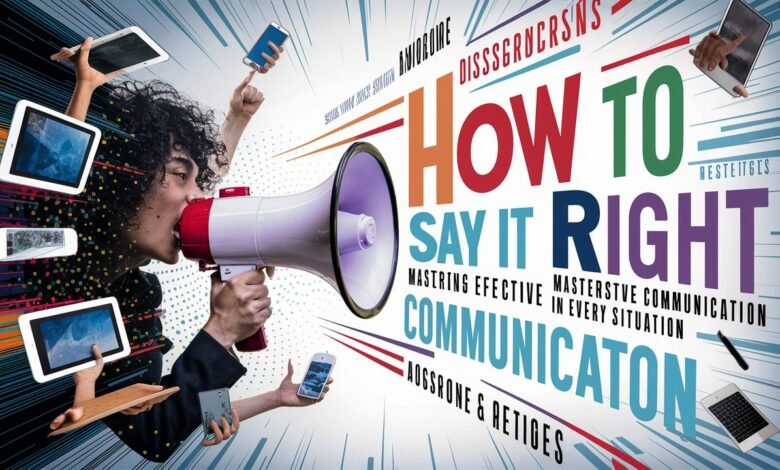How to Say It Right: Mastering Effective Communication in Every Situation

Introduction
In a world where communication shapes relationships, careers, and personal growth, knowing how to say something is just as important as what you say. Whether you’re delivering a speech, navigating a difficult conversation, or crafting an email, the nuances of language, tone, and body language can make or break your message. This article explores the art of effective communication, breaking down strategies to help you articulate ideas clearly, connect authentically, and leave a lasting impact. From verbal precision to emotional intelligence, we’ll dive into actionable techniques to elevate your communication skills in any context.
1. The Power of Clear Communication
Clear communication is the cornerstone of mutual understanding. It eliminates ambiguity, reduces misunderstandings, and fosters trust. To achieve clarity, focus on simplicity: avoid jargon, structure your thoughts logically, and prioritize key points. For example, in professional settings, starting with a summary of your main idea (e.g., “I recommend X strategy because…”) ensures your audience grasps the purpose upfront. Clarity also extends to non-verbal cues—maintaining eye contact and using gestures purposefully reinforces your message.
2. Verbal vs. Non-Verbal Communication: Striking the Balance
While words convey information, non-verbal signals—like facial expressions, posture, and tone—reveal emotions and intent. Studies suggest that 55% of communication is body language, 38% is tone, and only 7% relies on words alone. For instance, saying “I’m fine” with crossed arms and a monotone voice sends a conflicting message. To align verbal and non-verbal communication, practice mirroring your audience’s energy and calibrating your tone to match the context. In virtual meetings, this might mean exaggerating facial expressions to compensate for screen barriers.
3. Active Listening: The Unsung Hero of Dialogue
Effective communication isn’t just about speaking—it’s about listening. Active listening involves fully engaging with the speaker, asking open-ended questions, and paraphrasing their points to confirm understanding (e.g., “What I’m hearing is…”). This technique builds rapport and uncovers underlying concerns. In conflict resolution, acknowledging emotions (“It sounds like you’re frustrated because…”) can de-escalate tension. Avoid interrupting or formulating responses while the other person speaks; instead, focus on their perspective.
4. Cultural Sensitivity in Communication
In our globalized world, cultural differences shape how messages are interpreted. For example, direct communication styles common in Western cultures might seem confrontational in high-context societies like Japan, where indirectness is valued. Research your audience’s norms: address hierarchies appropriately, avoid idioms that don’t translate well, and respect silence as a form of deliberation. Adapting your approach demonstrates respect and prevents unintended offense.
5. Crafting Persuasive Messages
Persuasion relies on ethos (credibility), pathos (emotional appeal), and logos (logic). Start by establishing trust—share credentials or relatable anecdotes. Use storytelling to evoke emotions, such as sharing a customer’s success story. Finally, back your claims with data. In negotiations, framing benefits around the listener’s needs (“This solution saves your team 10 hours weekly”) increases buy-in. Avoid aggressive language; instead, invite collaboration (“What are your thoughts on this approach?”).
6. Overcoming Communication Anxiety
Fear of public speaking or difficult conversations is common. Combat anxiety with preparation: rehearse key points, visualize success, and adopt a power pose to boost confidence. During conversations, pause to breathe and collect your thoughts—silence is more powerful than filler words like “um.” Gradually exposing yourself to low-stakes scenarios (e.g., speaking up in small meetings) builds resilience over time.
7. Digital Communication: Navigating Emails and Social Media
Written communication lacks tone, making it prone to misinterpretation. In emails, use subject lines that summarize the purpose (“Action Required: Q3 Budget Approval”), and organize content with bullet points for readability. On social media, tailor your voice to the platform—professional on LinkedIn, conversational on Twitter. Always proofread to avoid typos, and when in doubt, opt for brevity over complexity.
8. Conflict Resolution Through Constructive Dialogue
Conflicts often arise from miscommunication. Address issues calmly using “I” statements to avoid blame (“I felt overwhelmed when deadlines shifted”). Focus on shared goals (“We both want this project to succeed”), and propose solutions collaboratively. If emotions run high, suggest taking a break and revisiting the conversation later.
Conclusion
Mastering how to say something is a lifelong skill that enhances every interaction. By prioritizing clarity, balancing verbal and non-verbal cues, and adapting to cultural contexts, you’ll build stronger relationships and drive meaningful outcomes. Remember, great communicators aren’t born—they’re made through practice, empathy, and a willingness to learn. Start small: observe others, seek feedback, and refine your approach. Over time, you’ll find your voice resonating louder and clearer than ever.
Frequently Asked Questions (FAQs)
Q1: How can I improve my non-verbal communication?
A: Record yourself in conversations or practice in front of a mirror. Notice habits like fidgeting or avoiding eye contact, and replace them with intentional gestures. Observing skilled communicators (e.g., TED speakers) can also provide insights.
Q2: What if I’m communicating with someone from a vastly different culture?
A: Research their communication norms beforehand. When in doubt, ask polite questions (“How would you prefer we approach this?”) to show respect and openness.
Q3: How do I handle criticism without becoming defensive?
A: Separate the message from the delivery. Respond with curiosity (“Can you help me understand your perspective?”) rather than justification. This shifts the dynamic from conflict to collaboration.
Q4: What’s the best way to structure a persuasive presentation?
A: Use the “Problem-Solution-Benefit” framework: outline the issue, propose your solution, and highlight tangible benefits. Stories and visuals (charts, images) make your case memorable.
Q5: How can I stay calm during high-pressure conversations?
A: Ground yourself with mindful breathing (inhale for 4 counts, exhale for 6). Focus on the goal of the conversation rather than fearing judgment—this reduces self-consciousness.
By integrating these strategies, you’ll transform how you say it into a tool for connection and influence.



